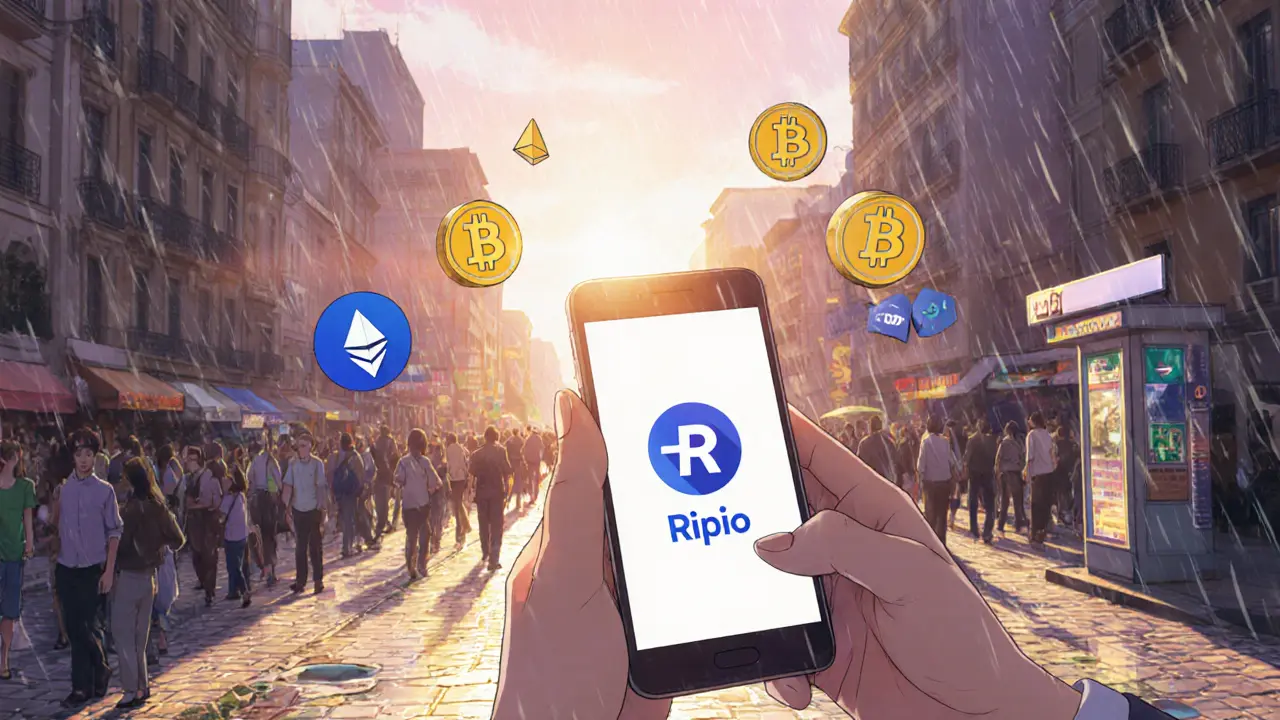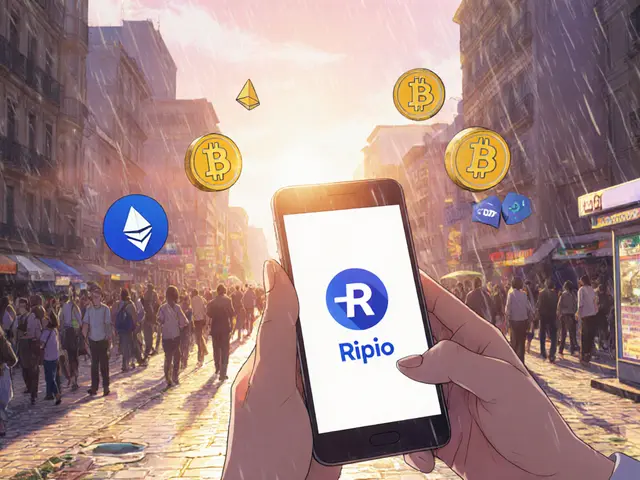Ripio Trading Fee Calculator
Calculate Your Trading Fees
See exactly what you'll pay when trading on Ripio based on your trade type and amount.
Note: Fees vary based on trade volume and market conditions. These are estimated fees based on Ripio's current fee structure (as of October 2025).
In 2025, Latin America accounted for more than 11% of global crypto trading volume, and one name that keeps popping up in the region is Ripio a cryptocurrency exchange built to serve Spanish‑speaking users in Argentina, Brazil, Mexico and other Latin American markets. If you’ve ever wondered whether Ripio lives up to the hype, this review breaks down every angle that matters: fees, security, local payment options, product lineup, and how it stacks up against the big global players.
Why Ripio Exists - The Market Gap It Fills
Traditional exchanges like Binance or Coinbase were historically geared toward users with easy access to USD‑based bank accounts. For many in BuenosAires or SãoPaulo, converting local pesos or reais into crypto meant dealing with expensive international wires and limited payment methods. Ripio was founded in 2013 precisely to close that gap. Its mission is simple: make crypto buying as easy as paying a utility bill, using familiar tools like MercadoPago, PIX or even cash‑out at Rapipago kiosks.
Core Product Suite
Ripio isn’t just a spot‑trading platform. The ecosystem includes:
- A web portal and native mobile apps for iOS and Android.
- A Crypto Visa Card that lets you spend Bitcoin, USDT or ETH at any merchant that accepts Visa, with a cashback program that refunds a slice of each purchase in the same crypto you spent.
- The proprietary LaChain blockchain, currently used for internal settlement and slated for DeFi pilots in 2026.
- Earn programs that automatically generate yields on select altcoins (0.02‑0.08% daily, depending on the asset).
Fee Structure - What You Actually Pay
Ripio follows a maker‑taker model. Maker fees range from 0% to 0.25% and taker fees from 0.10% to 0.50%. For most retail users the platform applies a flat 0.5% commission on buy‑sell orders, but cryptocurrency swaps (e.g., BTC→ETH) are fee‑free. By contrast, Binance charges as low as 0.016% maker and 0.036% taker, while Coinbase typically levies 0.5% on trades but offers a lower 0.3% fee for recurring purchases.
For users who trade frequently, the higher fees can add up, but Ripio compensates with localized payment methods and ultra‑low deposit minimums - as little as ARS100 (≈$0.11USD). The platform also waives fees for crypto‑to‑crypto swaps, which is a nice perk for seasoned traders who bounce between assets often.
Security Measures - How Your Funds Are Protected
Security is non‑negotiable, especially after several high‑profile exchange hacks in 2024. Ripio employs a layered defense:
- Cold storage holds roughly 95% of user assets offline.
- Two‑Factor Authentication (2FA) is mandatory for withdrawals.
- Regular Proof of Reserves (PoR) audits allow anyone to verify that the on‑chain balance matches the exchange’s reported holdings.
- SSL encryption and Cloudflare DDoS protection secure the web portal.
These measures place Ripio on par with global standards, though it lacks the insurance funds that some larger exchanges tout.
Local Payment Options - The Real Differentiator
Where Ripio shines is in its payment ecosystem. Argentine users can fund accounts via bank transfers, MercadoPago, or cash at Rapipago and Pagofacil. Brazilians enjoy instant PIX deposits, and Mexican users can link local banks directly. The platform displays real‑time conversion rates in ARS, BRL or MXN, so you see the exact amount of crypto you’ll receive before confirming the trade.
By contrast, Binance and Coinbase still rely heavily on USD or EUR deposits for most Latin American users, which often incurs extra conversion fees and longer processing times. This localized approach has helped Ripio capture roughly 18.7% of Argentina’s exchange market (Statista, Q32025).
Usability - Is the Platform Beginner Friendly?
The UI is clean and intuitive, especially for native Spanish speakers. Onboarding typically takes 24‑48hours after you upload a government‑issued ID, and most users can place their first trade within 15‑30minutes of account approval. Educational resources - from short video explainers to step‑by‑step guides - are accessible directly from the dashboard.
The biggest usability hurdle is the language lock: the entire platform, help center and legal docs are Spanish‑only. Non‑Spanish speakers must rely on community‑translated GitHub resources (last updated July2025) or use browser translation extensions, which adds friction.
Customer Support - What to Expect
Ripio offers 24/7 chatbot support and a ticket‑based email system. Average response times sit around 24‑48hours, according to Trustpilot (3.9/5 rating). The lack of live chat is a frequent complaint; users report waiting up to 72hours during market spikes. In contrast, Coinbase provides live chat and phone support, while Binance’s support is largely community‑driven but faster for high‑volume users.
Comparative Snapshot
| Feature | Ripio | Binance | Coinbase | Bitso |
|---|---|---|---|---|
| Supported crypto (as of Oct2025) | 54 (claims >1,200) | 350+ | 120+ | 80+ |
| Maker fee | 0%‑0.25% | 0.016% | 0%‑0.5% | 0%‑0.2% |
| Taker fee | 0.10%‑0.50% | 0.036% | 0.5% | 0.25%‑0.5% |
| Local fiat options | ARS, BRL, MXN + cash vouchers | USD, EUR (limited LATAM) | USD, EUR, GBP | MXN, ARS, PEN |
| Mobile app rating (iOS) | 3.8/5 | 4.6/5 | 4.4/5 | 4.2/5 |
| Live chat support | No | Limited | Yes | No |
| Crypto Visa Card | Yes | No | No | No |

Pros & Cons - TL;DR Takeaways
- Pros: Deep integration with Argentine, Brazilian and Mexican payment rails; Spanish‑first UX; Crypto Visa Card with cashback; PoR audits and strong cold‑storage policy.
- Cons: Higher trading fees than global rivals; no English interface; no live chat; limited to Latin America (no US or EU access).
Is Ripio Right for You?
If you live in Argentina, Brazil or Mexico and want to fund crypto with a local bank account or cash voucher, Ripio is probably the smoothest option. Its fee‑free swaps also make it attractive for users who move between tokens often.
However, if you trade large volumes, need the lowest possible fees, or require English‑language support, you might prefer Binance or Coinbase. The decision ultimately hinges on whether local convenience outweighs global cost efficiency.
Future Outlook - What’s Coming Next?
Ripio’s roadmap includes expanding LaChain to host DeFi lending pools in early 2026 and rolling out a second‑generation Crypto Visa Card with higher cashback percentages. The recent integration with Brazil’s PIX system is expected to boost user growth by 15‑20% year‑over‑year, according to Chainalysis.
Analysts warn that Binance’s aggressive Spanish localization could compress Ripio’s market share, but the exchange’s deep regulatory ties across multiple jurisdictions give it a defensive edge. If Latin America’s crypto adoption continues its projected 28% CAGR through 2030, Ripio should stay relevant-provided it upgrades its support channels and adds at least a basic English version.
Frequently Asked Questions
What currencies can I deposit into Ripio?
You can fund your account with Argentine pesos (ARS), Brazilian reais (BRL), Mexican pesos (MXN) via bank transfers, local e‑wallets like MercadoPago, instant PIX payments, or cash vouchers at Rapipago and Pagofacil.
Are there any hidden fees when using the Crypto Visa Card?
The card itself has no monthly fee. You pay the normal transaction fee (0.5% on purchases) and any network fees charged by the underlying blockchain. Cashback is credited automatically in the crypto you spent.
How secure is Ripio’s cold‑storage solution?
Approximately 95% of assets are kept offline in geographically dispersed vaults. The exchange publishes regular Proof of Reserves reports that anyone can verify on a public blockchain explorer.
Can I trade on Ripio without a Spanish‑speaking background?
The platform itself is Spanish‑only, but community‑maintained English translations are available on GitHub. Using a browser translator also works, though the experience isn’t seamless.
How does Ripio’s fee structure compare to Binance?
Ripio’s flat 0.5% commission on buy‑sell trades is higher than Binance’s maker‑taker rates (as low as 0.016% maker, 0.036% taker). However, Ripio offers fee‑free crypto‑to‑crypto swaps, which Binance charges a small taker fee for.


Shane Lunan
July 11, 2025 AT 08:03Ripio's fees are higher than Binance, but the local payments are decent.
Matthew Homewood
July 14, 2025 AT 16:33In the grand tapestry of Latin America’s financial evolution, platforms like Ripio represent more than a mere exchange-they are cultural bridges between fiat habit and decentralized ambition. The region’s 11% share of global crypto volume is not an accident, but a symptom of deep‑seated demand for accessible, low‑cost entry points. By integrating MercadoPago, PIX and even cash‑voucher networks, Ripio sidesteps the friction that has long plagued users of USD‑centric giants. This localization, however, comes at the price of a flatter 0.5% commission on spot trades, a figure that eclipses Binance’s sub‑0.1% taker rates. Yet the fee‑free swaps offered by Ripio restore some equilibrium for traders who hop between assets daily. Security-wise, the 95% cold‑storage ratio aligns with industry best practices, and the published Proof‑of‑Reserves audits provide a transparency layer rarely seen outside the “big three.” What the platform lacks, notably, is an insurance fund to cushion users in the event of a systemic breach, a gap that regulators are beginning to spotlight. From a user‑experience perspective, the Spanish‑only interface eliminates language barriers for the majority of its target market, but it also alienates the growing expatriate community seeking English support. The Crypto Visa Card, with its crypto‑backed cashback, hints at a future where digital assets become as liquid as fiat in everyday commerce. Its current 0.5% transaction fee mirrors traditional card costs, but the added reward in the same crypto spent could offset the expense for high‑frequency users. Looking ahead, the LaChain DeFi pilots slated for 2026 may transform Ripio from a gateway into a full‑stack financial ecosystem. If those pilots succeed, the platform could capture additional value beyond simple trading fees, potentially justifying its higher cost structure. Competitors such as Binance are now rolling out Spanish localization, which may compress Ripio’s market share unless it doubles down on regulatory relationships. Nevertheless, the platform’s deep ties with local banks and e‑wallets create a moat that is not easily replicated overnight. In sum, whether Ripio is “the best” depends on the individual’s priority matrix: convenience and local integration versus raw cost efficiency and multilingual support.
Jeff Moric
July 18, 2025 AT 04:01That’s a solid analysis. The balance between convenience and cost is indeed the core trade‑off for many users in the region. I’d add that the PoR audits are a strong trust signal, especially for newcomers wary of exchange solvency. Also, the local payment options really lower the barrier for first‑time crypto buyers. Overall, Ripio seems to prioritize accessibility over ultra‑low fees, which aligns with its mission.
Bruce Safford
July 21, 2025 AT 15:30Look, the whole "security" spiel is just a front. 95% cold‑storage sounds great until the vault key gets compromised by a hidden backdoor. 2024 hacks proved that even the best‑claimed audits can be faked. Plus, those PoR reports? They’re just numbers you can tweak if you control enough nodes. Don't forget the secret partnership with a shady offshore entity-rumor has it they’re using Ripio as a laundering hub. So before you trust "local convenience", remember the same ease can be used to move illicit funds across borders. The Visa card? Another way to skim small fees unnoticed. This is why I stay away from anything that doesn’t have an independent insurance fund.
Jordan Collins
July 25, 2025 AT 03:06The security architecture outlined in the review is indeed reassuring. Cold storage of 95% of assets aligns with industry standards, and mandatory 2FA adds an essential layer for withdrawals. Regular Proof of Reserves audits also give users a transparent way to verify backing, something many exchanges still overlook. While the lack of an insurance fund is a drawback, the combination of SSL encryption and DDoS protection helps safeguard the platform’s online presence. Overall, for users prioritizing a strong security posture in Latin America, Ripio presents a compelling option.
Andrew Mc Adam
July 28, 2025 AT 14:43Building on that, the security measures are only part of the story; the user experience amplifies their impact. Imagine a trader in Buenos Aires who can instantly verify the exchange’s reserves via a public explorer-this transparency reduces anxiety and encourages higher participation. The crypto Visa card, despite its modest fees, turns everyday purchases into a passive yield mechanism, effectively letting users earn while they spend. Moreover, the fee‑free swaps empower active traders to rebalance portfolios without eroding margins, a feature rarely seen in global exchanges. If Ripio continues to expand its DeFi offerings on LaChain, we could see a full ecosystem where security, convenience, and profitability intertwine, redefining how Latin Americans engage with digital finance.
Ken Lumberg
August 1, 2025 AT 02:20Crypto platforms like Ripio may look shiny, but they fuel a culture of speculative greed that erodes real economic stability. When people chase quick profits instead of building sustainable businesses, societies pay the price in volatility and inequality. It's irresponsible to celebrate an exchange simply because it offers convenient payment methods. We need to question whether facilitating easier access to unregulated assets is truly in the public interest.
Blue Delight Consultant
August 4, 2025 AT 13:56While the moral concerns raised are understandable, it's also important to recognize the transformative potential that platforms like Ripio bring to underserved populations. By providing a bridge between traditional fiat systems and decentralized finance, they can empower individuals who lack access to conventional banking. The ethical balance lies in fostering responsible usage alongside robust regulatory oversight.
Wayne Sternberger
August 8, 2025 AT 01:33In evaluating Ripio's support infrastructure, the 24‑hour chatbot offers a baseline of assistance, yet the 24‑48 hour ticket response time may hinder users during periods of market turbulence. Live chat, as found on competing platforms, could substantially improve resolution speed and user satisfaction. Nonetheless, the existing documentation and community resources help mitigate some of these delays, especially for users comfortable with self‑service solutions.
Gautam Negi
August 11, 2025 AT 13:10Contrary to the notion that a lack of live chat is a fatal flaw, one could argue that it nudges users toward deeper self‑education, which ultimately builds a more resilient community. Moreover, the reliance on automated systems reduces human error and bias, ensuring consistent service quality across time zones. In a rapidly evolving crypto landscape, such automation may be preferable to ad‑hoc human support.